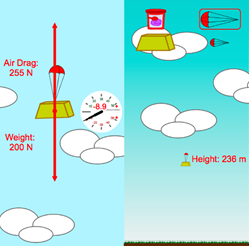 Skydiving
Skydiving
Resource:
Skydiving Interactive
Grade Level: High School
Description:
This interactive simulations explores forces acting on a skydiver in free fall with air resistance. Students can set initial height, add weight to the jumper, drop ballast, and change the size of the parachute. A force diagram displays the two forces acting on the skydiver. Using the tools, can you maneuver a smooth landing? The resource promotes deep understanding of the concepts of weight, acceleration due to gravity, drag caused by air resistance, and balanced/unbalanced forces. The activity provides a modeling opportunity for concept-building.
Performance Expectation:
Force and Motion (HS-PS2-1): Analyze data to support the claim that Newton’s Second Law of Motion describes the mathematical relationship among the net force on a macroscopic object, its mass, and its acceleration.
This activity aligns with the three dimensions of the Next Generation Science Standards in the manner described below:
| Force and Motion (HS-PS2.A.1) Newton’s Second Law accurately predicts changes in the motion of macroscopic objects. |
According to Newton’s Laws, an object will accelerate if the forces acting upon it are unbalanced. Students use a model to explore how falling objects initially accelerate because there is no force big enough to balance the downward force of gravity. But on Earth, as the object gains speed, it encounters an increasing amount of upward air resistance force. |
| Systems and System Models – Grades 9-12: When investigating or describing a system, the boundaries and initial conditions of the system need to be defined and their inputs and outputs analyzed and described using models. |
This resource explicitly addresses system inputs and outputs, as students interactively set initial conditions and add (or subtract) drag forces from a falling object. Modeling allows learners to explore in a risk-free environment where repeated trials can be run with varied inputs. The model automatically generates certain outputs, such as velocity and magnitude of interacting forces. |
| Developing and Using Models – Grades 9-12: Use a model based on evidence to illustrate the relationships between systems or between components of a system. |
The modeling activity presents the system of skydiver and parachute, allowing students to explore how the falling system is affected by gravity and air resistance, forces which act in opposite directions. The relationship between acceleration and size of parachute is clearly depicted and easily visualized. System components become even more important as the student tries to maneuver the skydiver/parachute system safely to the ground by using the tools to change weight and parachute size. |
Associated Reading from The Physics Classroom
Other Supporting Pages at The Physics Classroom:
View Infographic.
(Coming Soon)
Search the NGSS Corner
Maybe you're looking for something really specific that pertains to a desired topic and emphasizes one or more of the listed NGSS dimensions. Why not try a search of this section of our website? Simply select from one or more of the pull-down menus and click Search. This page will reload and a collection of possibilities will be displayed in this section of the page and sorted by relevancy.